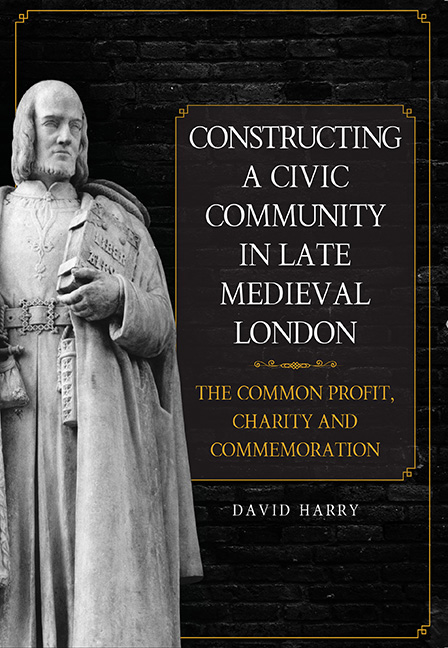Book contents
- Frontmatter
- Dedication
- Contents
- Acknowledgements
- Abbreviations
- Introduction: Common profit and charity in late medieval London
- 1 Radical London, 1376–86
- 2 Reconfiguring political authority
- 3 Civic ceremony and staging the limits of authority
- 4 The exemplary dead
- 5 Spiritual authority and the common profit
- 6 Print and the pursuit of the common profit
- Conclusion
- Bibliography
- Index
Introduction: Common profit and charity in late medieval London
Published online by Cambridge University Press: 04 April 2019
- Frontmatter
- Dedication
- Contents
- Acknowledgements
- Abbreviations
- Introduction: Common profit and charity in late medieval London
- 1 Radical London, 1376–86
- 2 Reconfiguring political authority
- 3 Civic ceremony and staging the limits of authority
- 4 The exemplary dead
- 5 Spiritual authority and the common profit
- 6 Print and the pursuit of the common profit
- Conclusion
- Bibliography
- Index
Summary
According to the chronicler Robert of Avesbury, employed in the court of the archbishop of Canterbury at Lambeth, the Black Death arrived in London on, or around, the feast of All Saints (1 November) 1348. Between Candlemas and Easter 1349, the virulence of the plague necessitated the building of three new burial grounds, one at East Smithfield, another, much larger, on the site of Charterhouse Square and a third at Tower Hill. The population of the city, which had been 70,000–100,000 in 1348, declined by between a third and a half during this time. The impact of the Black Death in London, as elsewhere in Western Europe, was transformative, ushering in a period of social realignment. In the aftermath of the plague, London experienced a series of financial and political crises. The Statute of Labourers (1349), for instance, forced urban craftsmen to sell goods at 1347 prices, even though workers’ wages were on the increase. In 1351 the franchise of the city was revoked in retaliation against the misconduct of the city's governing elite, intensifying conflict between London and foreign merchants. Tensions grew between the urban workforce and the city's most powerful guilds – Vintners, Fishmongers, Grocers, Mercers and Goldsmiths – who comprised the majority of the capital's aldermen, sheriffs and mayors. This was a period that saw the brief ascendancy of John of North-ampton, draper and mayor (1381–83). Northampton and his faction claimed to represent the interests of the city's lesser guilds and, with the support of powerful allies at court (including John of Gaunt), secured a number of short-lived reforms to the governance of London that threatened the hegemony of the victualling companies.
Yet this was also a period in which the capital began to dominate national finances and trade. We see an increased role for London at the heart of the English economy, a growing reliance of the crown on London merchants and an increased prominence of London representatives in parliament. The establishment of the staple at Calais in 1361 buoyed the London economy and, as an example, between 1366–67 and 1402, London's export of cloth rose from only 18 per cent of Bristol's to 51 per cent of the national export.
- Type
- Chapter
- Information
- Constructing a Civic Community in Late Medieval LondonThe Common Profit, Charity and Commemoration, pp. 1 - 22Publisher: Boydell & BrewerPrint publication year: 2019



